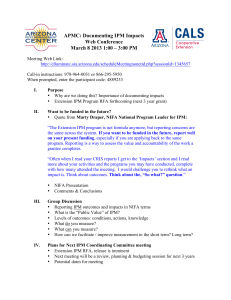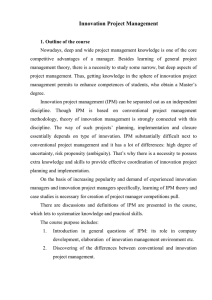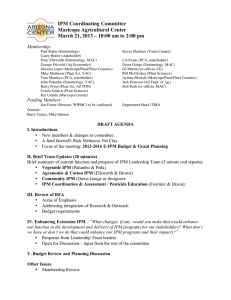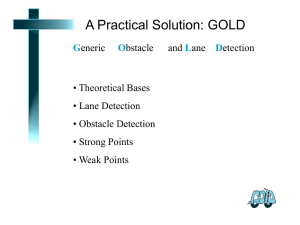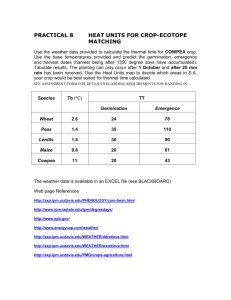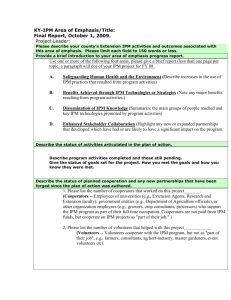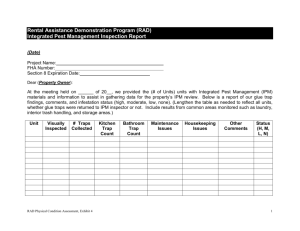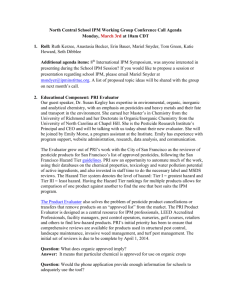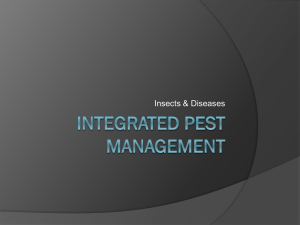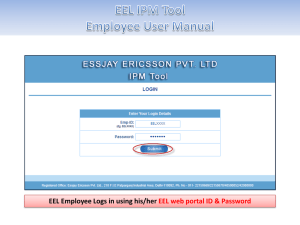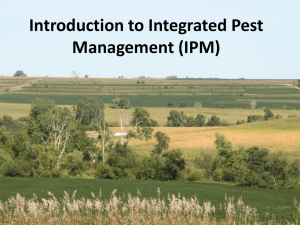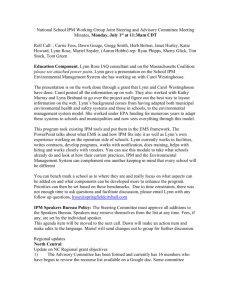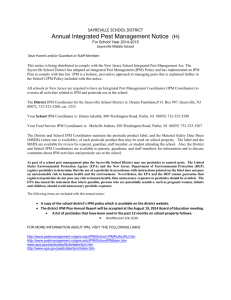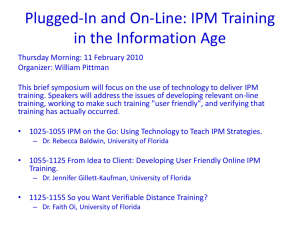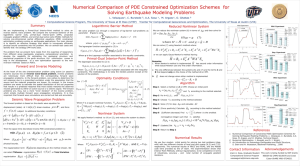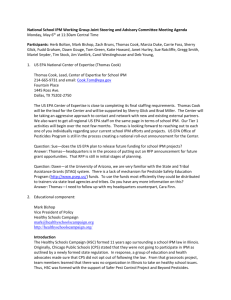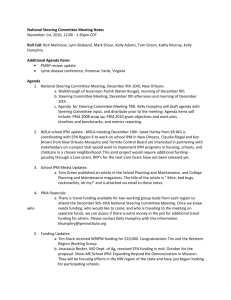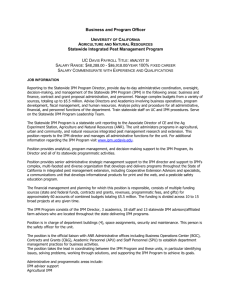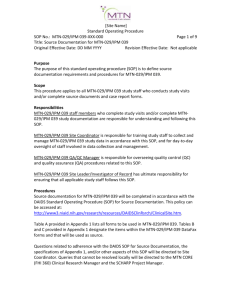12-09-13 Steering Committee Meeting Minutes
advertisement
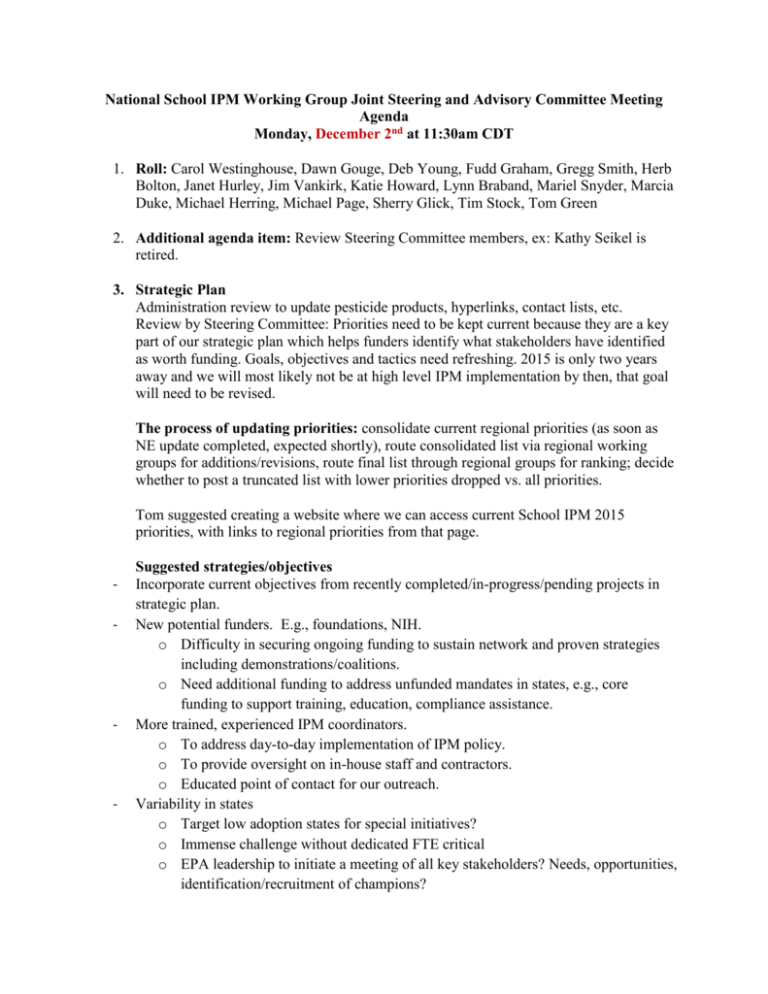
National School IPM Working Group Joint Steering and Advisory Committee Meeting Agenda Monday, December 2nd at 11:30am CDT 1. Roll: Carol Westinghouse, Dawn Gouge, Deb Young, Fudd Graham, Gregg Smith, Herb Bolton, Janet Hurley, Jim Vankirk, Katie Howard, Lynn Braband, Mariel Snyder, Marcia Duke, Michael Herring, Michael Page, Sherry Glick, Tim Stock, Tom Green 2. Additional agenda item: Review Steering Committee members, ex: Kathy Seikel is retired. 3. Strategic Plan Administration review to update pesticide products, hyperlinks, contact lists, etc. Review by Steering Committee: Priorities need to be kept current because they are a key part of our strategic plan which helps funders identify what stakeholders have identified as worth funding. Goals, objectives and tactics need refreshing. 2015 is only two years away and we will most likely not be at high level IPM implementation by then, that goal will need to be revised. The process of updating priorities: consolidate current regional priorities (as soon as NE update completed, expected shortly), route consolidated list via regional working groups for additions/revisions, route final list through regional groups for ranking; decide whether to post a truncated list with lower priorities dropped vs. all priorities. Tom suggested creating a website where we can access current School IPM 2015 priorities, with links to regional priorities from that page. - - - Suggested strategies/objectives Incorporate current objectives from recently completed/in-progress/pending projects in strategic plan. New potential funders. E.g., foundations, NIH. o Difficulty in securing ongoing funding to sustain network and proven strategies including demonstrations/coalitions. o Need additional funding to address unfunded mandates in states, e.g., core funding to support training, education, compliance assistance. More trained, experienced IPM coordinators. o To address day-to-day implementation of IPM policy. o To provide oversight on in-house staff and contractors. o Educated point of contact for our outreach. Variability in states o Target low adoption states for special initiatives? o Immense challenge without dedicated FTE critical o EPA leadership to initiate a meeting of all key stakeholders? Needs, opportunities, identification/recruitment of champions? - - - Congressional hearing on school IPM? o NPMA involvement key. IPest Manager o Beta version 2 nearly complete, trial planned for Salt Lake City schools. o Janet’s grant includes creating a mobile app. o Concern about how to develop sustainable model for broader adoption; need for school district IT help. o SchoolDude easier to use initially, IPest Manager more information but more challenging initially. Cooperative Educational Services Agency model, Wisconsin o What can we learn from this EPA-funded project; agency that provides broad services to school districts added IPM to their offerings. o CESA-like orgs exist in other states; is the model exportable? Road Map has been updated, should we expand our reach outside of schools? o www.ipmcenters.org/ipmroadmap.pdf Accomplishments Committee should review what we learned so far, including what we have learned through the surveys. Our overarching strategy about collaborating and coordinating has been working; there is much less duplication of efforts. This was apparent through the state level survey completed summer 2012. There is a strong indication that having this core network is working and helping us be more effective with increasing activity/advanced activity in more states. Room for growth The school district survey numbers suggest that we are at about a 20% adoption rate of credible IPM programs on paper. About 50% of respondents indicated they had an IPM coordinator, plan, policy, pre-approved list of pesticides and that routine applications were not being made. Taking into consideration the strong bias of individuals who completed the survey having an active IPM program to begin with, there is somewhere between 15-25% adoption rate, at least on paper. Important to focus on what are our key strategy is to to get those numbers up; IPM coordinator role and how important that role is. Specific objectives to include in the strategic plan are to increase the number of districts with a trained IPM coordinator. Next Steps Please review the ATTACHED outline for accuracy which we will discuss on our next call, January 6th at 11:30am (CDT). 4. Regional updates a. North Central We have some exciting news; Dawn Gouge had received funding to assist with the Standard Certification training modules and exams. This will be extremely helpful and speed the entire process. We will be reorganizing the committees that work on the project moving forward. There will be a development committee and a review committee. The development committee will be a small group that works closely with the PI’s of both grants to contribute and create the actual module and exams. The review committee will be large and consist of individuals from a variety of backgrounds that will provide helpful suggestions and feedback on how to improve the training material. If you are interested in joining the review committee please join us for a conference call on December 9th at 10:00am central time to learn more about how you can be a part of this project. Call information will be sent out this week. Jennifer Everhart will be leaving CESA 10; Jessica Schroeder will be taking over her grant reporting duties b. North Eastern: not successful with EPA grant fund. c. Southern Janet: The southern region put out a social network analysis of the working group, if you were sent that email please fill it out even if you are not part of the southern working group. The survey will show our collaboration. Dawn suggested a self-analysis of our own steering/advisory committees regarding demographics 5. IPM and PPDC group updates will be discussed on the next call. Next call: Monday, January 6th at 11:30am CDT There will not be a guest speaker; we will discuss our Strategic Plan
